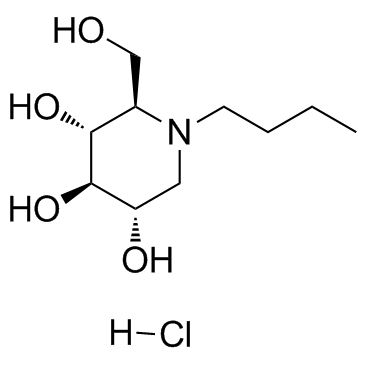Miglustat hydrochloride
Modify Date: 2024-01-17 17:10:41

Miglustat hydrochloride structure
|
Common Name | Miglustat hydrochloride | ||
|---|---|---|---|---|
| CAS Number | 210110-90-0 | Molecular Weight | 255.739 | |
| Density | N/A | Boiling Point | 421.2ºC at 760 mmHg | |
| Molecular Formula | C10H22ClNO4 | Melting Point | 169-172ºC | |
| MSDS | N/A | Flash Point | 208.5ºC | |
Use of Miglustat hydrochlorideMiglustat hydrochloride is an inhibitor of glucosylceramide synthase, primarily to treat Type I Gaucher disease (GD1).Target: OthersMiglustat is an inhibitor of the ceramide-specific glycosyltransferase, which catalyzes the first step of glycosphingolipid biosynthesis and is currently approved for the oral treatment of type 1 GD [1]. Consumption of a standard high-fat breakfast within 30 minutes before administration of miglustat significantly reduced peak exposure but did not significantly affect the extent of systemic exposure to miglustat. The peak plasma concentration (C(max)) decreased by 36% on average following administration with food. Area under the plasma concentration-time curve (AUC(0-infinity)) showed a modest (14%) decrease with food, but the 90% confidence interval was within the acceptance limit of 80% to 125%. The median (min-max) time to C(max) (t(max)) was prolonged from 2.5 (1.0-4.0) hours in the fasted state to 4.5 (1.5-8.0) hours in the fed state, whereas the apparent terminal half-life was approximately 8 hours and not affected by food [2]. |
| Name | N-Butyldeoxynojirimycin Hydrochloride |
|---|---|
| Synonym | More Synonyms |
| Description | Miglustat hydrochloride is an inhibitor of glucosylceramide synthase, primarily to treat Type I Gaucher disease (GD1).Target: OthersMiglustat is an inhibitor of the ceramide-specific glycosyltransferase, which catalyzes the first step of glycosphingolipid biosynthesis and is currently approved for the oral treatment of type 1 GD [1]. Consumption of a standard high-fat breakfast within 30 minutes before administration of miglustat significantly reduced peak exposure but did not significantly affect the extent of systemic exposure to miglustat. The peak plasma concentration (C(max)) decreased by 36% on average following administration with food. Area under the plasma concentration-time curve (AUC(0-infinity)) showed a modest (14%) decrease with food, but the 90% confidence interval was within the acceptance limit of 80% to 125%. The median (min-max) time to C(max) (t(max)) was prolonged from 2.5 (1.0-4.0) hours in the fasted state to 4.5 (1.5-8.0) hours in the fed state, whereas the apparent terminal half-life was approximately 8 hours and not affected by food [2]. |
|---|---|
| Related Catalog | |
| References |
| Boiling Point | 421.2ºC at 760 mmHg |
|---|---|
| Melting Point | 169-172ºC |
| Molecular Formula | C10H22ClNO4 |
| Molecular Weight | 255.739 |
| Flash Point | 208.5ºC |
| Exact Mass | 255.123734 |
| PSA | 84.16000 |
| Vapour Pressure | 7.37E-09mmHg at 25°C |
| Storage condition | 2-8℃ |
| Hazard Codes | Xi |
|---|
| Hydrogen chloride (2R,3R,4R,5S)-1-butyl-2-(hydroxymethyl)-3,4,5-piperidinetriol (1:1:1) |
| (2R,3R,4R,5S)-1-Butyl-2-(hydroxymethyl)piperidine-3,4,5-triol hydrochloride (1:1) |
| 3,4,5-Piperidinetriol, 1-butyl-2-(hydroxymethyl)-, chloride, hydrogen salt, (2R,3R,4R,5S)- (1:1) |
| Miglustat hydrochloride,(2R,3R,4R,5S)-1-Butyl-2-(hydroxymethyl)-3,4,5-piperidinetriolhydrochloride |
| Miglustat (hydrochloride) |